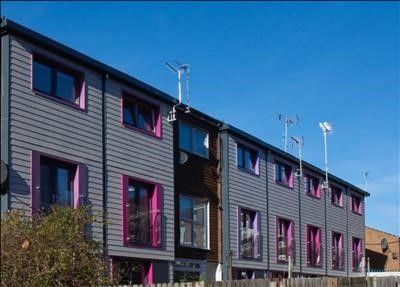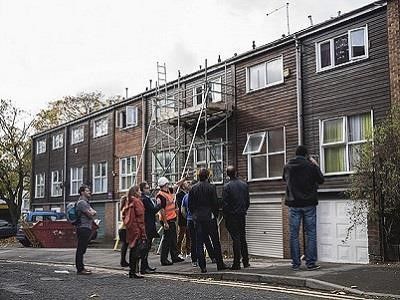Performance Before

Performance After

Description
The renovation of Sneinton district was implemented in the framework of the H2020 funded REMOURBAN project (http:// http://www.remourban.eu/).
The project included the renovation of a variety of property typologies in Nottingham within the Sneinton area ranging from single-family to multi-family houses, and in age, from 1900 to the 70s. A large number of the properties (65%) in the area are social housing, owned by Nottingham City Council (public owner) and managed on their behalf by Nottingham City Homes. The project included both energy efficiency measures (mainly walls insulation) and the connection to district heating.
As this project was also part of the Energiesprong UK programme, an “Energiesprong-type” package (with prefabricated façade) has been implemented.
Regarding financing, each home owner/private landlord received a Remourban grant towards the work, leaving a contribution of between 1.400€ and 2.536€ (£1,260 – £2,280) to pay, depending on the property type. Without the grant, this home improvement would normally cost upwards of 8.900€ (£8,000).
Local climate, constraints, regulations and incentives
Location
Nottingham, United KingdomClimate
Western- Climate: Western
- Local constraints: The mixed public/private ownership of buildings was a barrier because it affects decision making processes. The inefficient communication and confusion over sharing the responsibility between the different departments of the municipality resulted in delays.
- Incentives: The H2020 funding for these measures will be maximized with national Energy Company Obligation (ECO) funding. To help householders pay for their contribution, NEP and Nottingham Credit Union introduced a zero interest loan.
Lessons learnt and guidelines for replication
Lessons learnt
- Technical

In the framework of the REMOURBAN project, a series of technologies were implemented including photovoiltaic panels, local micro generation systems, insulation and ventilation measures and sustainable heating systems.
The main lesson learned concerned the importance of an integrated approach to the planning and management of technical solutions to adopt at district level from the beginning of project development.
- Financial & Economic
The most important lesson learnt regarding financial and economic issues is the importa nce of combining EC and national fundings for the economic feasibility of innovative large-scale solutions.
The main financial risks of the project have been around matching the internal funding with the rising costs of project delivery. This issue was solved thanks to a constant costs reworking by the project team, in order to ensure that the project can be delivered whilst also working under budget pressures.
- Regulatory & Administrative
The inefficient communication between the different departments of the municipality resulted in delays. In addition, there was administrative confusion over sharing the responsibility, especially between the financial and urbanism departments. For this reason, a cross-cutting smart city department was created in the municipality, designed to aid the implementation of these projects. The department did not function perfectly, but it has proved helpful in dealing with the administrative burdens.
- Social
 Owners/tenants have been consulted throughout the project, in both planning and implementation stages. The team has worked to develop good relationships with the residents, holding consultations within homes in the area and encouraging community champions to support the developments. The financial costs and benefits have always been discussed with the residents and their opinions sought. As the project requires their permission to be able to move ahead with the implementation, it has been essential to provide open and honest consultation throughout the project. This has been achieved through community consultation meetings as well as printed information.
Owners/tenants have been consulted throughout the project, in both planning and implementation stages. The team has worked to develop good relationships with the residents, holding consultations within homes in the area and encouraging community champions to support the developments. The financial costs and benefits have always been discussed with the residents and their opinions sought. As the project requires their permission to be able to move ahead with the implementation, it has been essential to provide open and honest consultation throughout the project. This has been achieved through community consultation meetings as well as printed information.
Recommendations
No specific recommendations for this case study.
